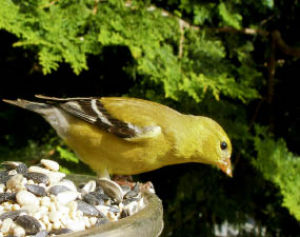Do you ever have a song or jingle crawling through your mind that just won’t stop? It is sometimes called an “earworm.”
Right now, I’m stuck on the Caribbean song, “Yellow Bird,” the version sung by the Mills Brothers.
“Yellow Bird, up high in banana tree.
Yellow Bird, you sit all alone like me.”
I wonder: Why that song right now?
At first I thought it reflected the great joy that my husband and I have had from watching a flock of 20 Evening Grosbeaks visit our seed feeder. These stocky, eight-inch finches have a rich butter yellow on their bodies and foreheads, and large white wing patches.
As the name suggests, Grosbeaks have big pale bills used for cracking large seeds and slurping up berries. This species prefers the mountains in our state but retreats into the lowlands in winter and decided to spend much of the late winter this year with us, or more accurately, with our seed feeder. However, Evening Grosbeaks tend to stay in a tight flock and don’t “sit all alone like me.”
Perhaps the “yellow bird” could be the American Goldfinch, our state bird. Throughout the winter, they would be better dubbed as the “dull green bird” while wearing their non-breeding plumage. Last week, I saw a recently molted male goldfinch sporting its bright yellow and black breeding feathers. I set out my thistle feeder to attract more of these freshly garbed buttercups.
Just yesterday, a friend mentioned seeing a Yellow-headed Blackbird up on the Skagit Flats. That species is rarely seen in western Washington, which may have triggered my earworm. We see flocks and flocks of both the Red-winged Blackbirds and Brewer’s Blackbirds here, but those species fade into the shadows beside the slightly larger Yellow-headed Blackbird with a brilliant yellow hood covering the bird’s head, neck and breast.
Then it hit me that the “yellow bird” must have come from the downy, day-old baby chicks that we recently picked up at the farm and garden store. Four of our “layers-to-be” are the Golden Comet variety and as sweet and yellow as any Easter chick or spring daffodil.
Still, it would be a stretch to think of these baby chicks as yellow birds “up high in banana trees.” Actually, none of the above-mentioned yellow birds would be caught dead in a banana tree. They are birds of northern climes, hundreds of miles and decades of degrees from where banana trees grow.
I went online to YouTube to hear the Mills Brothers singing “Yellow Bird,” hoping for inspiration. One version showed photos of lovely yellow birds as the Brothers crooned in the background.
The Yellow Warbler may be my answer. This all-yellow bird sits “up high in banana tree.” And, as the song goes, it “sits all alone like me.” Male warblers spend their spring calling from the tops of trees to attract a mate or announce that they claimed this territory.
The song continues:
“Did your lady friend
fly away again?”
Chances are good that, as the migrating and mating season progresses, the Yellow Warbler’s lady friend will be hidden down in the thick branches sitting on the nest.
But Yellow Warbles don’t winter here on Mercer Island and won’t return from banana land until late April or May. Anyway, I wasn’t thinking about that species until I watched the YouTube song.
As I look out my window at the dreary, blustery morning, I think of the warm sunny weather down south where the Yellow Warblers linger. Perhaps my earworm is merely a dream, and I’m wishing I were down south where there are many species of warblers, tanagers, flycatchers and other very yellow birds.
And the song ends with:
“Yellow Bird,
You’re more lucky than me.”
Frances Wood can be reached at wood@whidbey.com. She is the author of “Brushed by Feathers: A Year of Birdwatching in the West.”



